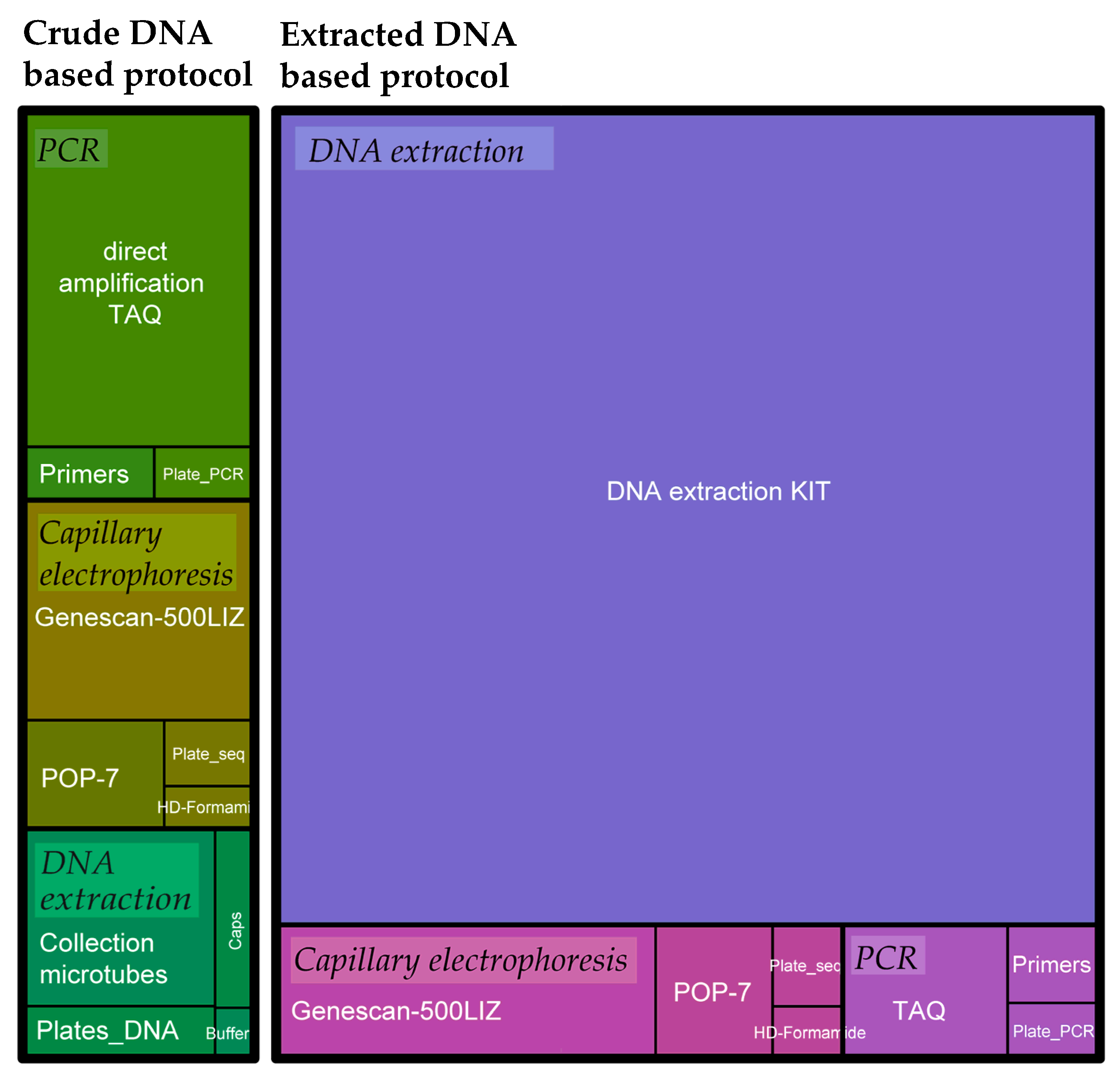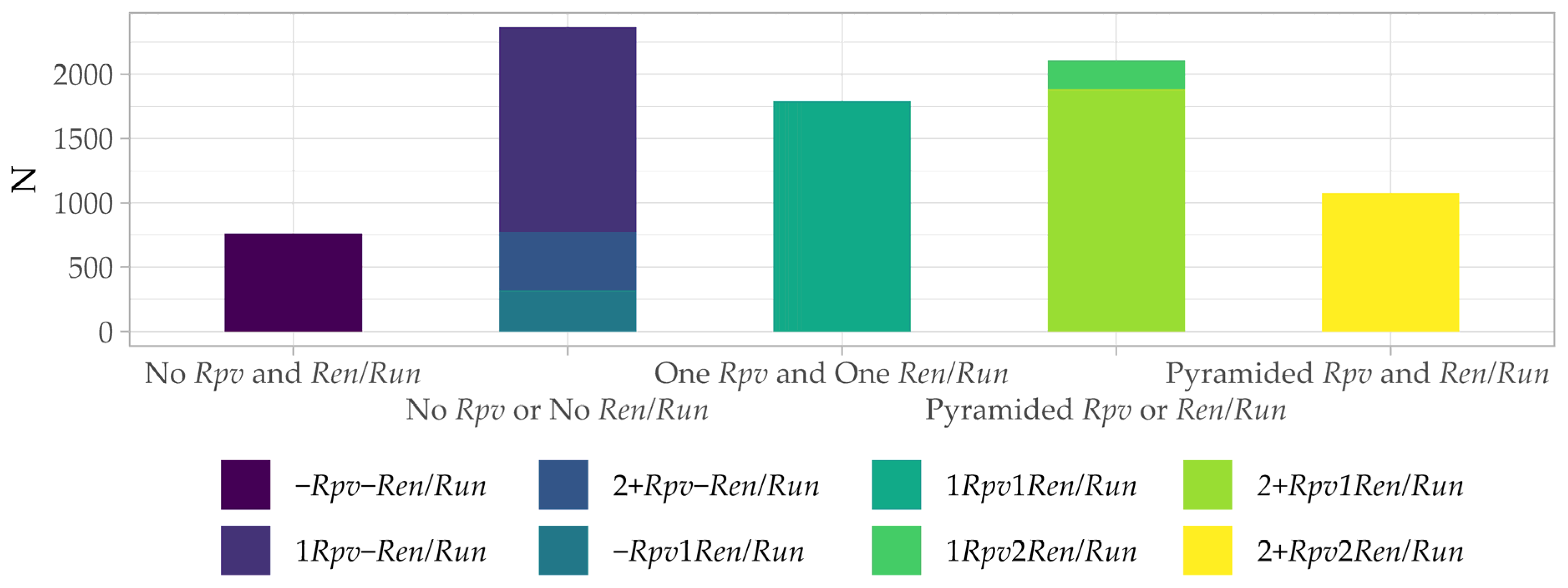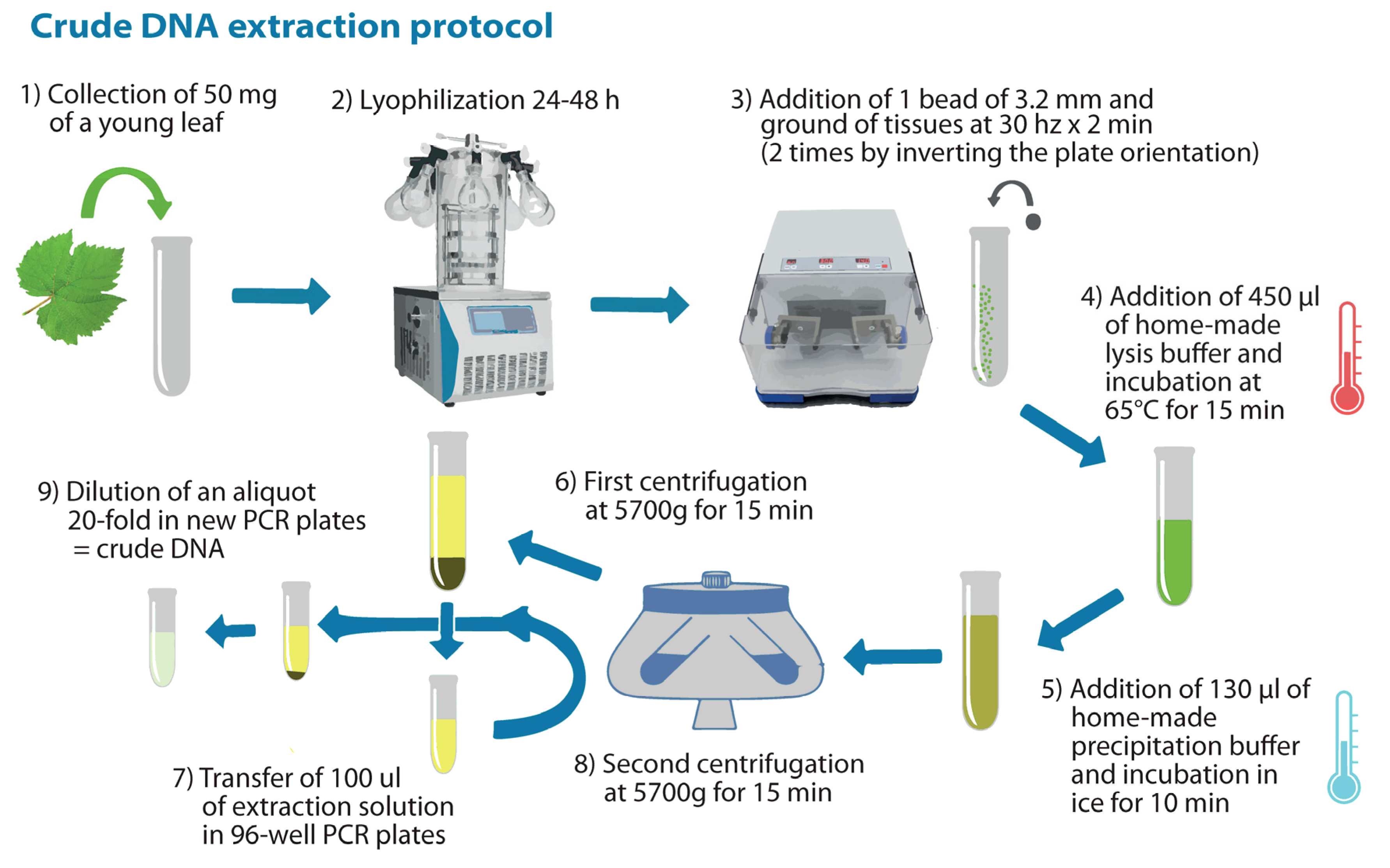A Sustainable Strategy for Marker-Assisted Selection (MAS) Applied in Grapevine (Vitis spp.) Breeding for Resistance to Downy (Plasmopara Viticola) and Powdery (Erysiphe Necator) Mildews
Abstract
:1. Introduction
2. Results
2.1. MAS Protocol and Genotyping
2.2. Grapevine Resistance Loci Segregation
3. Discussion
3.1. Crude DNA Based MAS
3.2. Grapevine Resistance Locigenotyping and Segregation
4. Materials and Methods
4.1. Plant Material
4.2. Genotyping of Parental Plants and Cross Populations
- About 50 mg of a young and shiny leaf were collected in 96-tube (1.2 mL) Collection Microtubes plates (Qiagen, Hilden, Germany);
- Samples were lyophilized (Christ Alpha 2–4 LD, Martin Christ Gefriertrocknungsanlagen GmbH, Osterode am Harz, Germany) for 24–48 h, sealed, and stored at room temperature until the processing date (for up to one month);
- One stainless steel bead of 3.2 mm was added to each tube, and the samples were processed twice at 30 Hz for 120 s (by inverting the internal/external side of the plates) in a Tissue-Lyser II instrument (Qiagen, Hilden, Germany) in order to ground the tissues to a fine powder;
- A total of 450 μL of home-made lysis buffer (Tris HCl 200 mM—pH 8, NaCl 250 mM, EDTA 25 mM and SDS 0.5%; (Lemke et al. [1] with minor modifications), pre-heated at 65 °C, was added to each sample. Then, the plates were mixed at 18 Hz for 50 s in the Tissue Lyser II, incubated in an oven at 65 °C for 15 min, and shaken 2–3 times during the lysis;
- A total of 130 μL of home-made precipitation buffer (KOAC 5 M—pH 6,5; [1]) was added to each sample, the plates were manually mixed for 15 s, and then stored in ice for 10 min;
- Collection Microtubes plates were centrifuged at 5700× g for 15 min to separate the solid particles from the solution;
- A total of 100 µL of the extraction solution of each sample was moved to the 96-well (200 µL) PCR plates;
- The PCR Plates were centrifuged at 5700× g for 15 min again to separate the solid particles transferred in the previous step;
- An aliquot of the extraction solutions diluted 20-fold was prepared and stored at −20 °C as ‘crude DNA’ in new 96-well PCR plates.
5. Conclusions
Supplementary Materials
Author Contributions
Funding
Data Availability Statement
Acknowledgments
Conflicts of Interest
References
- Lemke, L.; Rex, M.; Zyprian, E.; Töpfer, R. A Simple, Inexpensive and Environmentally Friendly Method for High Throughput DNA Extraction from Grapevine (Vitis spp.). VITIS-J. Grapevine Res. 2015, 50, 7–10. [Google Scholar] [CrossRef]
- Kim, C.; Guo, H.; Kong, W.; Chandnani, R.; Shuang, L.-S.; Paterson, A.H. Application of Genotyping by Sequencing Technology to a Variety of Crop Breeding Programs. Plant Sci. 2016, 242, 14–22. [Google Scholar] [CrossRef] [PubMed]
- Lu, J.; Hou, J.; Ouyang, Y.; Luo, H.; Zhao, J.; Mao, C.; Han, M.; Wang, L.; Xiao, J.; Yang, Y.; et al. A Direct PCR–Based SNP Marker–Assisted Selection System (D-MAS) for Different Crops. Mol. Breed. 2020, 40, 9. [Google Scholar] [CrossRef]
- Sharma, R.; Kumar, V.; Mohapatra, T.; Khandelwal, V.; Vyas, G.K. A Simple and Non-Destructive Method of Direct-PCR for Plant Systems. J. Plant Biol. 2012, 55, 114–122. [Google Scholar] [CrossRef]
- Steiner, J.J.; Polemba, C.J.; Fjellstrom, R.G.; Elliott, L.F. A Rapid One-Tube Genomic DNA Extraction Process for PCR and RAPD Analyses. Nucl. Acids Res. 1995, 23, 2569–2570. [Google Scholar] [CrossRef]
- Testolin, R.; Messina, R.; Cipriani, G.; De Mori, G. SSR-based DNA Fingerprinting of Fruit Crops. Crop Sci. 2023, 63, 390–459. [Google Scholar] [CrossRef]
- Guichoux, E.; Lagache, L.; Wagner, S.; Chaumeil, P.; Léger, P.; Lepais, O.; Lepoittevin, C.; Malausa, T.; Revardel, E.; Salin, F.; et al. Current Trends in Microsatellite Genotyping. Mol. Ecol. Resour. 2011, 11, 591–611. [Google Scholar] [CrossRef] [PubMed]
- Collard, B.C.Y.; Mackill, D.J. Marker-Assisted Selection: An Approach for Precision Plant Breeding in the Twenty-First Century. Phil. Trans. R. Soc. B 2008, 363, 557–572. [Google Scholar] [CrossRef] [PubMed]
- Collard, B.C.Y.; Das, A.; Virk, P.S.; Mackill, D.J. Evaluation of “quick and Dirty” DNA Extraction Methods for Marker-Assisted Selection in Rice (Oryza sativa L.). Plant Breed. 2007, 126, 47–50. [Google Scholar] [CrossRef]
- Gessler, C.; Pertot, I.; Perazzolli, M. Plasmopara Viticola: A Review of Knowledge on Downy Mildew of Grapevine and Effective Disease Management. Phytopathol. Mediterr. 2011, 50, 3–44. [Google Scholar]
- Gadoury, D.M.; Cadle-Davidson, L.; Wilcox, W.F.; Dry, I.B.; Seem, R.C.; Milgroom, M.G. Grapevine Powdery Mildew (Erysiphe necator): A Fascinating System for the Study of the Biology, Ecology and Epidemiology of an Obligate Biotroph. Mol. Plant Pathol. 2012, 13, 1–16. [Google Scholar] [CrossRef] [PubMed]
- Wilcox, W.F.; Gubler, W.D.; Uyemoto, J.K. (Eds.) Compendium of Grape Diseases, Disorders, and Pests, 2nd ed.; The American Phytopathological Society: St. Paul, MN, USA, 2015; ISBN 978-0-89054-481-5. [Google Scholar]
- Pertot, I.; Caffi, T.; Rossi, V.; Mugnai, L.; Hoffmann, C.; Grando, M.S.; Gary, C.; Lafond, D.; Duso, C.; Thiery, D.; et al. A Critical Review of Plant Protection Tools for Reducing Pesticide Use on Grapevine and New Perspectives for the Implementation of IPM in Viticulture. Crop Prot. 2017, 97, 70–84. [Google Scholar] [CrossRef]
- Nicolopoulou-Stamati, P.; Maipas, S.; Kotampasi, C.; Stamatis, P.; Hens, L. Chemical Pesticides and Human Health: The Urgent Need for a New Concept in Agriculture. Front. Public Health 2016, 4, 148. [Google Scholar] [CrossRef] [PubMed]
- Komárek, M.; Čadková, E.; Chrastný, V.; Bordas, F.; Bollinger, J.-C. Contamination of Vineyard Soils with Fungicides: A Review of Environmental and Toxicological Aspects. Environ. Int. 2010, 36, 138–151. [Google Scholar] [CrossRef] [PubMed]
- Sambucci, O.; Alston, J.M.; Fuller, K.B.; Lusk, J. The Pecuniary and Nonpecuniary Costs of Powdery Mildew and the Potential Value of Resistant Grape Varieties in California. Am. J. Enol. Vitic. 2019, 70, 177–187. [Google Scholar] [CrossRef]
- Trapp, O.; Töpfer, R. Adoption of New Winegrape Cultivars to Reduce Pesticide Use in Europe: From the ASEV Climate Change Symposium Part 1—Viticulture. Am. J. Enol. Vitic. 2023, 74, 0740032. [Google Scholar] [CrossRef]
- Possamai, T.; Wiedemann-Merdinoglu, S. Phenotyping for QTL Identification: A Case Study of Resistance to Plasmopara viticola and Erysiphe necator in Grapevine. Front. Plant Sci. 2022, 13, 930954. [Google Scholar] [CrossRef] [PubMed]
- Dry, I.; Riaz, S.; Fuchs, M.; Sosnowski, M.; Thomas, M. Scion Breeding for Resistance to Biotic Stresses. In The Grape Genome; Cantu, D., Walker, M.A., Eds.; Compendium of Plant Genomes; Springer International Publishing: Cham, Switzerland, 2019; pp. 319–347. ISBN 978-3-030-18600-5. [Google Scholar]
- Merdinoglu, D.; Wiedeman-Merdinoglu, S.; Coste, P.; Dumas, V.; Haetty, S.; Butterlin, G.; Greif, C. Genetic Analysis of Downy Mildew Resistance Derived from Muscadinia rotundifolia. Acta Hortic. 2003, 451–456. [Google Scholar] [CrossRef]
- Fischer, B.M.; Salakhutdinov, I.; Akkurt, M.; Eibach, R.; Edwards, K.J.; Töpfer, R.; Zyprian, E.M. Quantitative Trait Locus Analysis of Fungal Disease Resistance Factors on a Molecular Map of Grapevine. Theor. Appl. Genet. 2004, 108, 501–515. [Google Scholar] [CrossRef]
- Zyprian, E.; Ochßner, I.; Schwander, F.; Šimon, S.; Hausmann, L.; Bonow-Rex, M.; Moreno-Sanz, P.; Grando, M.S.; Wiedemann-Merdinoglu, S.; Merdinoglu, D.; et al. Quantitative Trait Loci Affecting Pathogen Resistance and Ripening of Grapevines. Mol. Genet. Genom. 2016, 291, 1573–1594. [Google Scholar] [CrossRef]
- Vezzulli, S.; Malacarne, G.; Masuero, D.; Vecchione, A.; Dolzani, C.; Goremykin, V.; Mehari, Z.H.; Banchi, E.; Velasco, R.; Stefanini, M.; et al. The Rpv3-3 Haplotype and Stilbenoid Induction Mediate Downy Mildew Resistance in a Grapevine Interspecific Population. Front. Plant Sci. 2019, 10, 204. [Google Scholar] [CrossRef]
- Schwander, F.; Eibach, R.; Fechter, I.; Hausmann, L.; Zyprian, E.; Töpfer, R. Rpv10: A New Locus from the Asian Vitis Gene Pool for Pyramiding Downy Mildew Resistance Loci in Grapevine. Theor. Appl. Genet. 2012, 124, 163–176. [Google Scholar] [CrossRef] [PubMed]
- Venuti, S.; Copetti, D.; Foria, S.; Falginella, L.; Hoffmann, S.; Bellin, D.; Cindrić, P.; Kozma, P.; Scalabrin, S.; Morgante, M.; et al. Historical Introgression of the Downy Mildew Resistance Gene Rpv12 from the Asian Species Vitis amurensis into Grapevine Varieties. PLoS ONE 2013, 8, e61228. [Google Scholar] [CrossRef]
- Pauquet, J.; Bouquet, A.; This, P.; Adam-Blondon, A.-F. Establishment of a Local Map of AFLP Markers around the Powdery Mildew Resistance Gene Run1 in Grapevine and Assessment of Their Usefulness for Marker Assisted Selection. Theor. Appl. Genet. 2001, 103, 1201–1210. [Google Scholar] [CrossRef]
- Hoffmann, S.; Di Gaspero, G.; Kovács, L.; Howard, S.; Kiss, E.; Galbács, Z.; Testolin, R.; Kozma, P. Resistance to Erysiphe necator in the Grapevine “Kishmish Vatkana” Is Controlled by a Single Locus through Restriction of Hyphal Growth. Theor. Appl. Genet. 2008, 116, 427–438. [Google Scholar] [CrossRef] [PubMed]
- Welter, L.J.; Göktürk-Baydar, N.; Akkurt, M.; Maul, E.; Eibach, R.; Töpfer, R.; Zyprian, E.M. Genetic Mapping and Localization of Quantitative Trait Loci Affecting Fungal Disease Resistance and Leaf Morphology in Grapevine (Vitis vinifera L). Mol. Breed. 2007, 20, 359–374. [Google Scholar] [CrossRef]
- Zendler, D.; Schneider, P.; Töpfer, R.; Zyprian, E. Fine Mapping of Ren3 Reveals Two Loci Mediating Hypersensitive Response against Erysiphe necator in Grapevine. Euphytica 2017, 213, 68. [Google Scholar] [CrossRef]
- Culley, T.M.; Stamper, T.I.; Stokes, R.L.; Brzyski, J.R.; Hardiman, N.A.; Klooster, M.R.; Merritt, B.J. An Efficient Technique for Primer Development and Application That Integrates Fluorescent Labeling and Multiplex PCR. Appl. Plant Sci. 2013, 1, 1300027. [Google Scholar] [CrossRef] [PubMed]
- Oetting, W.S.; Lee, H.K.; Flanders, D.J.; Wiesner, G.L.; Sellers, T.A.; King, R.A. Linkage Analysis with Multiplexed Short Tandem Repeat Polymorphisms Using Infrared Fluorescence and M13 Tailed Primers. Genomics 1995, 30, 450–458. [Google Scholar] [CrossRef]
- De Nardi, B.; Santellani, F.; Tomasi, D. Miglioramento Genetico Della Glera per La Resistenza Alle Malattie. In Proceedings of the Acta Italus Hortus; Italian Society for Horticultural Science: Pisa, Italy, 2016; Volume 19, pp. 129–130. [Google Scholar]
- De Nardi, B.; Santellani, F.; Possamai, T.; Velasco, R. Breeding for Mildew Resistance in Grapevine to Improve Environmental and Socio-Economic Sustainability in Hotspot Areas of Veneto. Acta Hortic. 2019, 1248, 313–318. [Google Scholar] [CrossRef]
- Canaguier, A.; Grimplet, J.; Di Gaspero, G.; Scalabrin, S.; Duchêne, E.; Choisne, N.; Mohellibi, N.; Guichard, C.; Rombauts, S.; Le Clainche, I.; et al. A New Version of the Grapevine Reference Genome Assembly (12X.v2) and of Its Annotation (VCost.V3). Genom. Data 2017, 14, 56–62. [Google Scholar] [CrossRef] [PubMed]
- Migliaro, D.; Morreale, G.; Gardiman, M.; Landolfo, S.; Crespan, M. Direct Multiplex PCR for Grapevine Genotyping and Varietal Identification. Plant Genet. Resour. 2013, 11, 182–185. [Google Scholar] [CrossRef]
- De Mori, G.; Testolin, R.; Cipriani, G. A Molecular Protocol for Early Sex Discrimination (ESD) in Actinidia spp. J. Berry Res. 2022, 12, 249–266. [Google Scholar] [CrossRef]
- Zou, C.; Karn, A.; Reisch, B.; Nguyen, A.; Sun, Y.; Bao, Y.; Campbell, M.S.; Church, D.; Williams, S.; Xu, X.; et al. Haplotyping the Vitis Collinear Core Genome with rhAmpSeq Improves Marker Transferability in a Diverse Genus. Nat. Commun. 2020, 11, 413. [Google Scholar] [CrossRef] [PubMed]
- Delame, M.; Prado, E.; Blanc, S.; Robert-Siegwald, G.; Schneider, C.; Mestre, P.; Rustenholz, C.; Merdinoglu, D. Introgression Reshapes Recombination Distribution in Grapevine Interspecific Hybrids. Theor. Appl. Genet. 2019, 132, 1073–1087. [Google Scholar] [CrossRef] [PubMed]
- Possamai, T.; Wiedemann-Merdinoglu, S.; Merdinoglu, D.; Migliaro, D.; De Mori, G.; Cipriani, G.; Velasco, R.; Testolin, R. Construction of a High-Density Genetic Map and Detection of a Major QTL of Resistance to Powdery Mildew (Erysiphen necator Sch.) in Caucasian Grapes (Vitis vinifera L.). BMC Plant Biol. 2021, 21, 528. [Google Scholar] [CrossRef] [PubMed]
- Riaz, S.; Tenscher, A.C.; Rubin, J.; Graziani, R.; Pao, S.S.; Walker, M.A. Fine-Scale Genetic Mapping of Two Pierce’s Disease Resistance Loci and a Major Segregation Distortion Region on Chromosome 14 of Grape. Theor. Appl. Genet. 2008, 117, 671–681. [Google Scholar] [CrossRef]
- Sánchez-Mora, F.D.; Saifert, L.; Zanghelini, J.; Assumpção, W.T.; Guginski-Piva, C.A.; Giacometti, R.; Novak, E.I.; Klabunde, G.H.; Eibach, R.; Vesco, L.D.; et al. Behavior of Grape Breeding Lines with Distinct Resistance Alleles to Downy Mildew (Plasmopara viticola). Crop Breed. Appl. Biotechnol. 2017, 17, 141–149. [Google Scholar] [CrossRef]
- Töpfer, R.; Trapp, O. A Cool Climate Perspective on Grapevine Breeding: Climate Change and Sustainability Are Driving Forces for Changing Varieties in a Traditional Market. Theor. Appl. Genet. 2022, 135, 3947–3960. [Google Scholar] [CrossRef]
- Merdinoglu, D.; Schneider, C.; Prado, E.; Wiedemann-Merdinoglu, S.; Mestre, P. Breeding for Durable Resistance to Downy and Powdery Mildew in Grapevine. OENO One 2018, 52, 203–209. [Google Scholar] [CrossRef]
- Mundt, C.C. Pyramiding for Resistance Durability: Theory and Practice. Phytopathology 2018, 108, 792–802. [Google Scholar] [CrossRef] [PubMed]
- Possamai, T.; Migliaro, D.; Gardiman, M.; Velasco, R.; De Nardi, B. Rpv Mediated Defense Responses in Grapevine Offspring Resistant to Plasmopara viticola. Plants 2020, 9, 781. [Google Scholar] [CrossRef] [PubMed]
- Agurto, M.; Schlechter, R.O.; Armijo, G.; Solano, E.; Serrano, C.; Contreras, R.A.; Zúñiga, G.E.; Arce-Johnson, P. Run1 and Ren1 Pyramiding in Grapevine (Vitis vinifera cv. Crimson Seedless) Displays an Improved Defense Response Leading to Enhanced Resistance to Powdery Mildew (Erysiphe necator). Front. Plant Sci. 2017, 8, 758. [Google Scholar] [CrossRef] [PubMed]
- Di Gaspero, G.; Copetti, D.; Coleman, C.; Castellarin, S.D.; Eibach, R.; Kozma, P.; Lacombe, T.; Gambetta, G.; Zvyagin, A.; Cindrić, P.; et al. Selective Sweep at the Rpv3 Locus during Grapevine Breeding for Downy Mildew Resistance. Theor. Appl. Genet. 2012, 124, 277–286. [Google Scholar] [CrossRef] [PubMed]
- Barker, C.L.; Donald, T.; Pauquet, J.; Ratnaparkhe, M.B.; Bouquet, A.; Adam-Blondon, A.-F.; Thomas, M.R.; Dry, I. Genetic and Physical Mapping of the Grapevine Powdery Mildew Resistance Gene, Run1, Using a Bacterial Artificial Chromosome Library. Theor. Appl. Genet. 2005, 111, 370–377. [Google Scholar] [CrossRef] [PubMed]
- Bellin, D.; Peressotti, E.; Merdinoglu, D.; Wiedemann-Merdinoglu, S.; Adam-Blondon, A.-F.; Cipriani, G.; Morgante, M.; Testolin, R.; Di Gaspero, G. Resistance to Plasmopara viticola in Grapevine ‘Bianca’ Is Controlled by a Major Dominant Gene Causing Localised Necrosis at the Infection Site. Theor. Appl. Genet. 2009, 120, 163–176. [Google Scholar] [CrossRef]
- Coleman, C.; Copetti, D.; Cipriani, G.; Hoffmann, S.; Kozma, P.; Kovacs, L.; Morgante, M.; Testolin, R.; Di Gaspero, G. The Powdery Mildew Resistance Gene Ren1 Co-Segregates with an NBS-LRR Gene Cluster in Two Central Asian Grapevines. BMC Genet. 2009, 10, 89. [Google Scholar] [CrossRef]




| Pathogen | Resistance Locus | Chromosome | Locus-Associated SSR | Resistance-Associated Alleles 6 |
|---|---|---|---|---|
| P. viticola | Rpv3.1 Rpv3.2 Rpv3.3 | 18 | UDV734 VMC7f2 | 233 3–237 1–241 2 200 2;3–211 1 |
| Rpv10 | 9 | Gf09-47 | 297 | |
| Rpv12 | 14 | UDV350 UDV360 | 308 | |
| 208 | ||||
| P. viticola/ E. necator | Rpv1/Run1 | 12 | VMC4f3.1 | 192 |
| VMC8g9 | 157 | |||
| E. necator | Ren1.1 Ren1.2 | 13 | SC8-0071-014 sc47_20 | 147 4–149 5 206 4–208 5 |
| Ren3/Ren9 | 15 | Gf15-30 | 445 | |
| Gf15-28 | 342 |
| Pop. Code | Seed Parent | Pollen Donor | Segregating Loci | Segregation Distortions | ||
|---|---|---|---|---|---|---|
| Locus | Expected % | Observed % | ||||
| 19_33 | Glera | 01-01-686 | Rpv12; Rpv1/Run1 | Rpv12 | 0.50 | 0.59 |
| 19_34 | Glera | 01-01-881 | Rpv12; Rpv1/Run1 | Rpv12 | 0.50 | 0.65 |
| 19_35 | Glera | Floreal | Rpv3.1; Rpv1/Run1; Ren3/Ren9 | None | ||
| 20_38 | Glera | Vc531_039 | Rpv3.1; Rpv12; Rpv1/Run1; Ren1.1 | Rpv1/Run1 | 0.50 | 0.40 |
| 20_41 | SK-00-1/7 | Glera | Rpv3.1; Rpv12; Rpv1/Run1; Ren3/Ren9 | Rpv1/Run1 | 0.50 | 0.36 |
| 20_42 | Glera | Vc156_1017 | Rpv12; Rpv1/Run1 | Rpv1/Run1 | 0.50 | 0.42 |
| 20_43 | Glera | Vc109_033 | Rpv12; Rpv1/Run1; Ren3/Ren9 | Rpv12 | 0.50 | 0.90 |
| Rpv1/Run1 | 0.50 | 0.40 | ||||
| 21_44 | Shavtsitska | 14_05d_023 | Rpv3.3; Rpv10; Ren1.2; Ren3/Ren9 | None | ||
| 21_45 | Souvignier gris | Vc109_033 | Rpv3.2; Rpv12; Rpv1/Run1; Ren3/Ren9 | Rpv12 | 0.50 | 0.87 |
| Possible distortions for Rpv1/Run1 and Rpv3.2 | ||||||
Disclaimer/Publisher’s Note: The statements, opinions and data contained in all publications are solely those of the individual author(s) and contributor(s) and not of MDPI and/or the editor(s). MDPI and/or the editor(s) disclaim responsibility for any injury to people or property resulting from any ideas, methods, instructions or products referred to in the content. |
© 2024 by the authors. Licensee MDPI, Basel, Switzerland. This article is an open access article distributed under the terms and conditions of the Creative Commons Attribution (CC BY) license (https://creativecommons.org/licenses/by/4.0/).
Share and Cite
Possamai, T.; Scota, L.; Velasco, R.; Migliaro, D. A Sustainable Strategy for Marker-Assisted Selection (MAS) Applied in Grapevine (Vitis spp.) Breeding for Resistance to Downy (Plasmopara Viticola) and Powdery (Erysiphe Necator) Mildews. Plants 2024, 13, 2001. https://doi.org/10.3390/plants13142001
Possamai T, Scota L, Velasco R, Migliaro D. A Sustainable Strategy for Marker-Assisted Selection (MAS) Applied in Grapevine (Vitis spp.) Breeding for Resistance to Downy (Plasmopara Viticola) and Powdery (Erysiphe Necator) Mildews. Plants. 2024; 13(14):2001. https://doi.org/10.3390/plants13142001
Chicago/Turabian StylePossamai, Tyrone, Leonardo Scota, Riccardo Velasco, and Daniele Migliaro. 2024. "A Sustainable Strategy for Marker-Assisted Selection (MAS) Applied in Grapevine (Vitis spp.) Breeding for Resistance to Downy (Plasmopara Viticola) and Powdery (Erysiphe Necator) Mildews" Plants 13, no. 14: 2001. https://doi.org/10.3390/plants13142001








